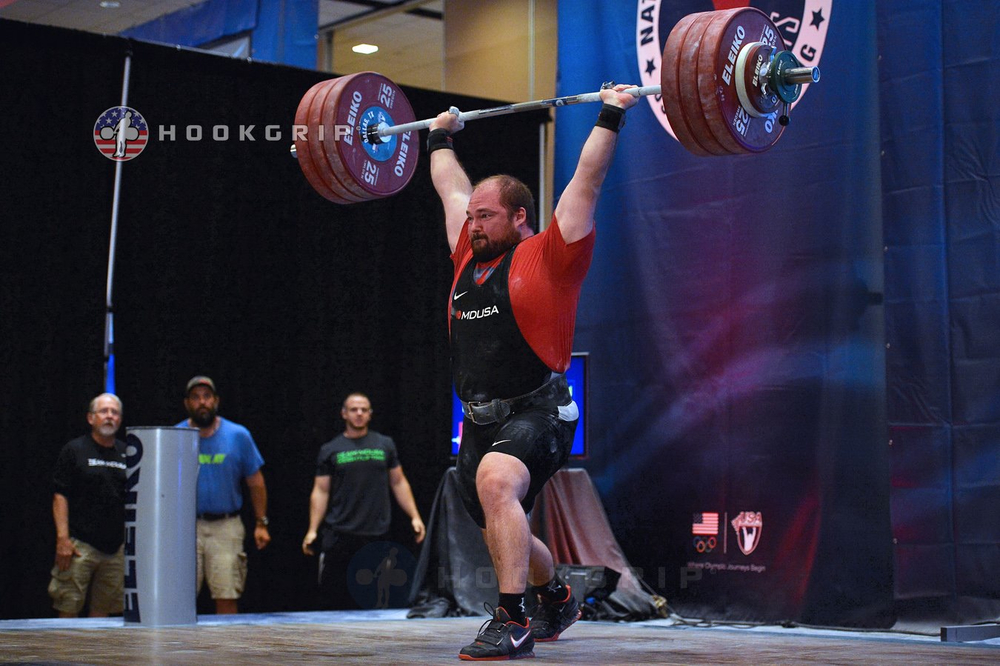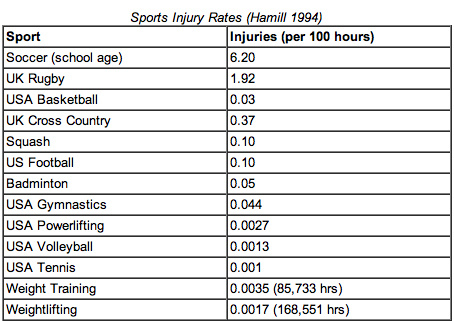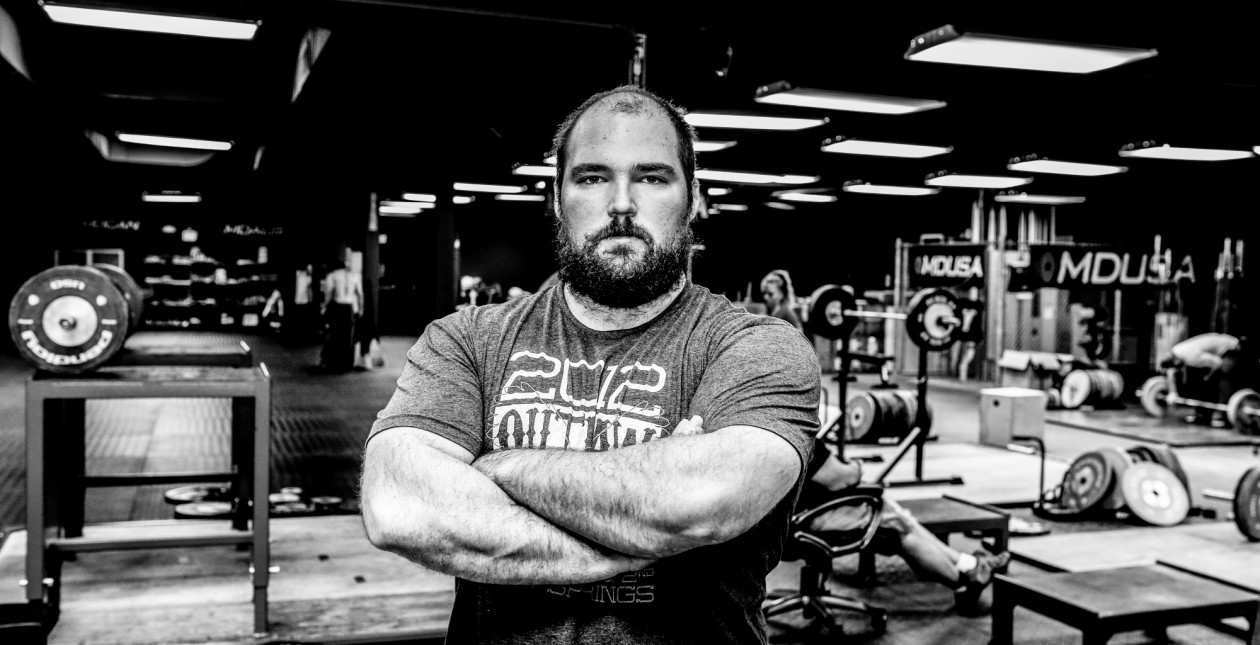Before you read this awesome article by my friend Sean Rigsby, I want to remind you all that I have two more “Mash Mafia Workshops & Train” this year. November 7th I will be in Eagan, MN at Undisputed Strength and Conditioning, and then November 14th at the Mash Compound in Clemmons, NC. Find out more by clicking on the link below:
>>>>Mash Mafia Workshops and Train<<<<
A competitor’s ability to overcome and endure pain may elevate them to the title of champion when the moment arises. The capacity for pain tolerance differs from each individual, and in sport I find hard to argue that the tougher competitor does not have an edge. More than being tough, though, is being realistic. While the endurance of pain may allow athletes to rise, knowing the difference when something is injury and how to deal with it will definitively divide a champion from the runner up.
In weightlifting, we are fortunate to have a relatively low incidence of injury. Below is a chart from a 1994 conducted in the UK which lists weightlifting at the bottom, but 0.0017 injuries incurred per 100 hours of sport practice. I’ve been in weightlifting long enough to know that this isn’t necessarily accurate, but typically the injuries incurred are minor and of chronic nature. The weightlifter will endure hip and shoulder impingement from overuse, but it is rare that they will suffer major injuries such as rotator or labral tears, or the debilitating cruciate ligament injuries so often seen in field sports.
In spite of this low incidence, injury happens. All the time. More frustratingly so, injury sometimes isn’t definitive. Due to high volume of knee injury other sports, recovery protocols and timelines are fairly standardized with timelines and advancements in therapy happening every day. Things like partial hip labral tears, or herniated disks are certainly fixable, but their timeline is rarely linear and recovery somewhat tenuous. These can disturb consistent training, the hallmark of a weightlifter’s lifestyle. Sometimes these nagging issues can become much bigger issues by affecting parts of the body not previously affected. I can speak from veritable experience that a shoulder injury can quickly become a shoulder, elbow, and wrist injury.
So you’re injured. Depending on the severity, it’s likely that in typical weightlifter fashion you probably shrugged it off, took it easy a few days and waited for it to get better. Still not better? What do you do?
1. Seek Professional Help
This can mean many things. A physical therapist, a chiropractor, an orthopedic, an applied kinesiologist, etc. If you have a coach worth their salt (oh and let’s not get started on whether or not you have a coach; it will take too long), they should be plugged in locally with some practitioners who understand your sport and the demands. Have an online coach? There are networks, such as Clinical Athlete, starting to become available that can get you in touch with practitioners in your area. Even contacting a local high school or college sports team to find out who they work with would be a good start. Don’t have insurance or the ability to pay for care? Don’t do sports. If you read Travis Mash’s material, I assume there is a competitive fire in you to aim for excellence. Having the ability to access this kind of care is a prerequisite.
2. Identify The Issue
Not everything requires an MRI. Sometimes it might. But whoever you’re working with should be able to tell you confidently what the issue is. Guesswork is wasted time. Be somewhat skeptical but not questionable. An orthopedic surgeon gets paid to cut people open and rarely spends a lot of time with you doing manual assessment. In my own experience, until you pay for an MRI, which may only confirm surgery isn’t required, they tend not to give you the time of day. Other practitioners will at least give you some personal time to assess. If they are still unsure of diagnosis, go ahead and get that MRI. The ability to definitively identify is the first step to recovery.
3. Develop A Plan Of Treatment
This may mean undergoing surgery. This may mean attempting some new techniques like PRP. Or it can simply mean doing some manual therapy with corrective exercise. Sit down with your consultant and develop a plan for the coming weeks, months, etc. Meandering into the gym without a plan isn’t very useful and psychologically crippling. The philosophy of “let’s see what I can do today” is useful at times, but not when on the road to recovery. Have a plan. Which leads to….
4. Execute
Commit to that plan. Is it fun hobbling on crutches and doing TKEs? Nope. Is doing the Buchberger 12 as exciting as maxing out your snatch? Hell no. Will other people in the gym who look in top form compared to your rehabilitatory state start to piss you off? Depends on your personal disposition, but for me it’s a resolute yes. This is why developing a plan is crucial, but being on paper is no good without day to day execution. Set a time check off each day. Did you really do everything you possibly could have to make sure you’ll be back on the platform soon?
Take your recovery work seriously and you will one day dominate again. Focus your energy into these avenues. In a damaged state it is counter-productive to your recovery to invest heavily in other strenuous activity or to decimate your caloric intake. Healing is a stressful process that requires fuel, and introducing unnecessary outside stress while limiting the resources available will prolong the process.
Now that you’re feeling better, remember the old Mash maxim for all athletic performance that will hopefully prevent any further setbacks in your training: Be Master of the Mundane. We can expand more on what that exactly should mean next time.
Sean Rigsby is a multiple time Senior National Medalist in Olympic Weightlifting. As a member of Team MDUSA, he has contributed to several National Championship Team Titles and risen through the ranks as a competitive 105kg+ lifter. Sean has worked with and studied from some of the best coaches in the country, including Don McCauley, Glenn Pendlay, Travis Mash, Chris Wilkes, and Zygmunt Smalcerz. Sean is currently in the process of completing his undergraduate degree in English and holds multiple professional certifications. He provides remote coaching, free CrossFit programming, and lifestyle apparel through Heavy Metal Barbell Club. You can visit www.heavymetalbarbellclub.com to find out more or follow Sean on Instagram @seanmrigsby.
For more information on one of my Online Teams, click on the links below:
Eat What You Want! Lift What You Want!
Team GridStyle for Functional Fitness Tailored to You!
For Online Coaching and Mentoring from Coach Mash, click on the link below:



